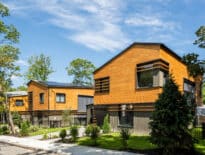
Gary Kerr
Late last year, Boston’s housing market received a failing grade from the Boston Foundation’s Annual Report card, with housing costs increasing faster than the incomes of the poorest third of families in the city. While Boston is not alone in these circumstances, there is one factor that gives Boston’s situation a unique twist; the enormous number of college students that call the city home.
Boston is home to over 150,000 college students, which represents a significant slice of its overall population. By focusing on the development of student housing specifically, there is an opportunity to tackle the broader housing challenges facing the region.
This starts with acknowledging that many colleges and universities are experiencing a minor crisis of their own. According to the Urban Institute, strong enrollment growth is outpacing the development of on-campus housing, partially due to financing challenges. Due to a lack of available beds, students move off-campus in search of housing in nearby neighborhoods – often targeting multi-bedroom units where rent can be shared with roommates to reduce living expenses. As a result, apartments intended to house families have become de facto dorms.
As difficult as the financial competition between students and families is, co-habituating in the same building brings additional challenges given the stark contrasts in lifestyles. It is a recipe for eroding the bonds between a university and its host community.
Schools’ Two Main Options
If traditional on-campus student housing development is not feasible, cash-strapped schools do have additional options they should consider. One model that has recently emerged in this market is public-private partnerships, or P3s. These arrangements see schools lease project sites to a private development partner that provides funding and building support.
There is significant opportunity for schools to benefit from these arrangements. P3s offer a workaround to the financing gap that inhibits new projects from moving forward. Private partners also bring the expertise to develop buildings more efficiently – both in time and money – and can also bring operational expertise once the building is open. This ensures a maintained quality of the housing over time. A recent P3 between Greystar and University of Massachusetts Dartmouth enabled the school to retire four outdated residential buildings and replace them with a modern housing, academic and dining complex.
P3s also enable schools to focus financial resources towards the mission critical aspects of the campus. This shifts the risk for universities in a multitude of ways, through development, financing, occupancy and long-term operation and maintenance risk, and allows them to focus on what they do best: educating students. In the UMass-Dartmouth P3, Greystar’s use of tax-exempt bond financing not only enabled the school to offer affordable rental rates, it allowed them to focus its funds on other core campus projects.
Another avenue is private student housing, in which projects designed specifically for students and not tied to one particular institution are built and run like traditional market-rate residential projects. This is especially attractive for areas abutted by multiple schools where their enrollments can be aggregated as prospective occupants. Communities can also benefit; private student housing creates new options designed to be attractive to students that can help free up existing housing stock for families.
Restrictive Zoning Stymies Projects
Previous attempts to build private student housing in the Fenway neighborhood of Boston have been stymied by community opposition, questioning if off-campus sites are best suited to build housing specific to students. These concerns, however, are short-sighted. They fail to recognize the impact students have in these neighborhoods and that the goal – to free up existing housing stock – is a mutually-aligned objective, with a different approach.
Beyond the community concerns, planning officials reviewing that proposed project cited existing zoning that prohibited student-only housing in that area, which ultimately impeded the developer from moving forward as planned. Anyone familiar with that area of Boston knows it’s in proximity to more than a half-dozen schools, including two of the state’s largest by enrollment, and that college students are already living there en masse. The state of the neighborhood, and many others, calls into question the intention of the zoning.
Restrictive zoning repeatedly comes up as a hindrance for alleviating the housing crisis. By reassessing zoning to find opportunities where student housing can be built by-right, leaders can help to incentivize developers to build projects. Of course, any rezoning should consider proximity to schools and the existing density of students in a particular neighborhood to ensure projects are to the benefit of the community.
In a city with more than 150,000 students, bolstering student housing options in adjacent neighborhoods is critical to open more multifamily housing options for the general population. Because of its unique demographics, Boston is the perfect place to demonstrate the significant impact that these projects can make.
Gary Kerr is managing director of development at Greystar, overseeing its Northeast operations.





